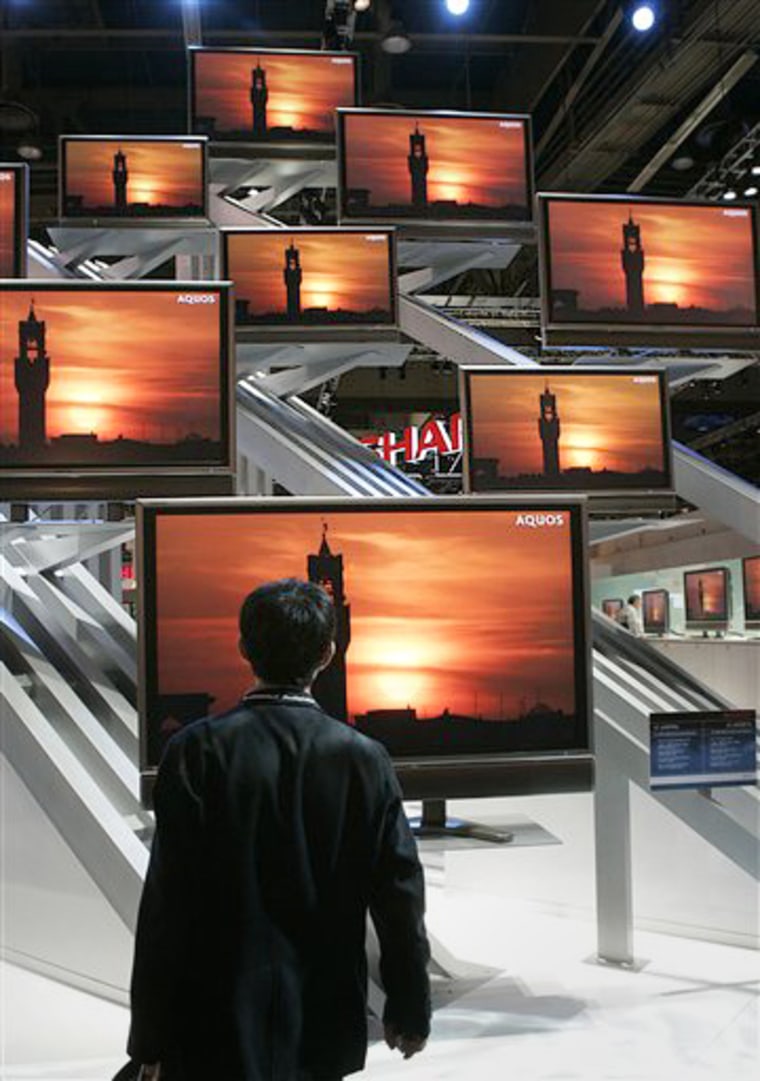For TV shoppers and sellers, Super Bowl XL is Christmas II.
While shopping for most consumer electronics peaks around Christmastime, the Super Bowl on Feb. 5 sends the holiday season into overtime for TVs.
"The NFL and the college bowl season is the gift that keeps on giving for us," said Randy Baumberger, president and chief operating officer of Ultimate Electronics, a retailer with 32 western U.S. stores.
The holiday selling season is still the company's largest. But while sales of digital cameras and audio equipment drops off after Christmas, television sales stay strong in January. And the broadcast of NFL games in high definition can provide the extra incentive to upgrade sets.
"You probably have to go back to the transition between black and white and color to see what we're seeing today," Baumberger said of the booming sales of digital TVs.
TV shoppers won't have any trouble finding a place to buy.
"You can now buy TVs at supermarkets and office superstores, not to mention Costco and Wal-Mart," said Paul Semenza, vice president of display and consumer research at TV parts-tracker iSuppli Corp. Even Home Depot and clothing retailer Kohl's have been selling LCD TVs.
Sales of the 10 best-selling models of televisions in January 2005 were $875.9 million, higher than 8 of the 11 preceding months, according to data from the NPD Group, Inc. And analysts say many sports-related TV sales are made in December right after Christmas.
George Creighton, operations manager for a Circuit City store in Rockville, Md., says it's not uncommon for shoppers to wait until game day. On the morning of Dec. 18, when the Redskins played the rival Dallas Cowboys, his store sold three high-end TVs to people who wanted a better set for the game.
Because big sporting events are often the main reason people buy high-def televisions, retailers heavily promote TVs during January, said Eric Haruki, an analyst at IDC.
There are other factors, too.
Microsoft Corp.'s new video game console, the Xbox 360, displays games in high definition, and Sony Corp.'s Playstation 3 will, too, when it goes on sale later this year.
Analysts differ on how much the video game consoles influence sales, though Microsoft Chairman Bill Gates asserted last week that nine out of 10 Xbox 360 owners have a high-definition television or plan to get one.
Falling prices are helping, too. Thirty to 34-inch LCD TVs sold for an average of $2,379 this time last year. That has dropped to $1,566 now, said Semenza of iSuppli. TV shoppers can thank innovations from Asian manufacturers.
Screen-makers are also figuring out how to handle larger pieces of glass, which means they can make plasma screens more efficiently and charge less. For example, a TV maker would have paid $676 for a 32-inch screen in January 2005. By December that had fallen to $544, Semenza said. Prices are expected to keep dropping.
Though ongoing pricing wars have cut retail prices and gross margins to levels lower than vendors would like, the TVs are still not cheap.
"It's like buying a car in the old days. I bought a car for less than this thing costs," said Ben Zimmerman, 71, during a visit to a Best Buy in the Minneapolis suburb of Roseville. He and his wife were picking out the TV they were buying each other for their anniversary. They settled on a 26-inch Sony, which they planned to use mostly for watching DVDs.
He ended up paying about $1,800 for an LCD TV, and shelled out another $250 for an extended warranty.
The big discount stores generally offer bare-bones service — you pretty much walk in and pick out the TV you want. Best Buy and Circuit City Stores Inc. sell installation packages, and increasingly those extra services help to drive profits. That's fine with them.
Haruki said prices drop even lower at online-only retailers. His survey of more than 40 resellers found a Samsung 50-inch projection HDTV selling online for $1,600 versus $2,500 suggested retail. He said some buyers are overcoming their reluctance to make such a big-ticket purchase online by looking at the TV first in the store.
"The consumer is not going to continue to ignore the pricing (difference), because it's just too vast right now," he said.
Upstart TV brands now fight for shelf space with established makers like Sony and Samsung Electronics Co. Some familiar names like Zenith and RCA have been bought by companies that slap those brands on Asian-built TVs. Semenza said 88 percent of TVs sold worldwide are built in Asia.
Shoppers are seeing new brands, too, such as Vizio TVs from V Inc. The company's headquarters are in California but like most sellers its TVs come from overseas. Haruki said V Inc. jump-started its Vizio brand by selling through Costco. Costco margins are thin but Vizio gained a national footprint quickly, he said. Vizio TVs are now sold at several other retailers as well.
Some of the early Vizio TVs sold for as much as $600 less than similar Panasonic models, said Haruki, adding that the Vizio may not have been quite the Panasonic's equal, but "bang-for-the-buck wise, it's very, very good."
But buyer beware:
Gerard Catapano, manager of audio, video and imaging at Consumer Reports, says performance on many of the newer brands is "typically inconsistent."
"We found very few did well, compared to a known name brand, like a Sony or Panasonic, which performed more consistently," he said. "We would shy away from them unless you have a specific recommendation."
Even with all the new TV brands fighting for shelf space, the price drops have had more to do with cheaper manufacturing costs than competition between retailers, said Crowell, Weedon & Co. electronics analyst James Ragan.
He guesses that retailers are still getting margins in the low 20 percent range.
"Over time, the competition will become even more intense. There will be a time when the margins are impacted a bit," said Ragan.
